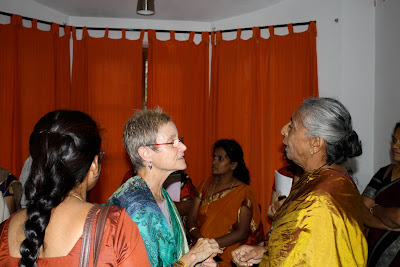Dr. Vijaya Srinivas, one of the physicians at PHRII, has been planning this training for many months. From developing the training manual, securing a clinical site, to recruiting physicians to be trained and patients to be seen, it has been a busy couple of months. All that planning paid off, as everything went without any problems!
Day 1 consisted of a presentation at PHRII by PINCC’s Dr. Rhoda. She presented a basic overview of the epidemiology of cervical cancer, as well as the screening and treatment methods being utilized during the training.
The presentation was open to the public and there were a few big names from Mysore in the audience, like the head of Mysore Medical College seen here.
Dr. Anjali Arun also made an appearance.
After the presentation there was some good dialogue about the state of cervical cancer in clinics throughout Mysore.
Day 2 was spent organizing the staff and setting up the clinic at St. Joseph’s Hospital, one of the newest hospitals in Mysore. Day 3, 4, and 5 were spent seeing patients and conducting the training.
The process was pretty complex. We had previously recruited patients from all over Mysore city, including Ekalavyanagar, the slum community we sponsored in 2008. We had to get all of these women to the clinic, so all three drivers were kept very busy shuttling patients to and from the clinic. Second, the patients had to be registered and then given a detailed explanation about the screening and examination procedures.
Next, the patients met with a counselor to fill out a basic clinical information sheet and to provide consent to participate in the program.
Finally, the patients were able to see the clinicians. Any women who did not meet the criteria to have the visual inspection done received a PAP, which was sent out to the pathology department at Vikram Hospital. Most women were found to have a healthy cervix. For the women with pre-cancerous lesions, the team was able to provide same-day treatment and obtain a biopsy for further testing. The team also identified other gynecological problems, including a few prolapsed uteruses.
Here's a pic of Dr. Vijaya and her new headlamp!
Women were typically nervous in the beginning, as this was the first pelvic exam for most of them! However, when the patients came out of the exam room with smiles on their faces, all the other patients were able to relax. The women were also able to comfort each other in groups before and after seeing the clinicians. Here are some satisfied patients who have already seen the clinicians.
All in all, the program was a great success! In 2.5 clinic days, we screened 139 women. This included 43 PAP smears, 15 biopsies, and 2 LEEP procedures (same-day treatment for pre-cancerous lesions).
We have plans to do another PINCC training in early December. There was also interest in starting a community referral network for cervical cancer screening amongst clinics and physicians in Mysore. Exciting news!





















